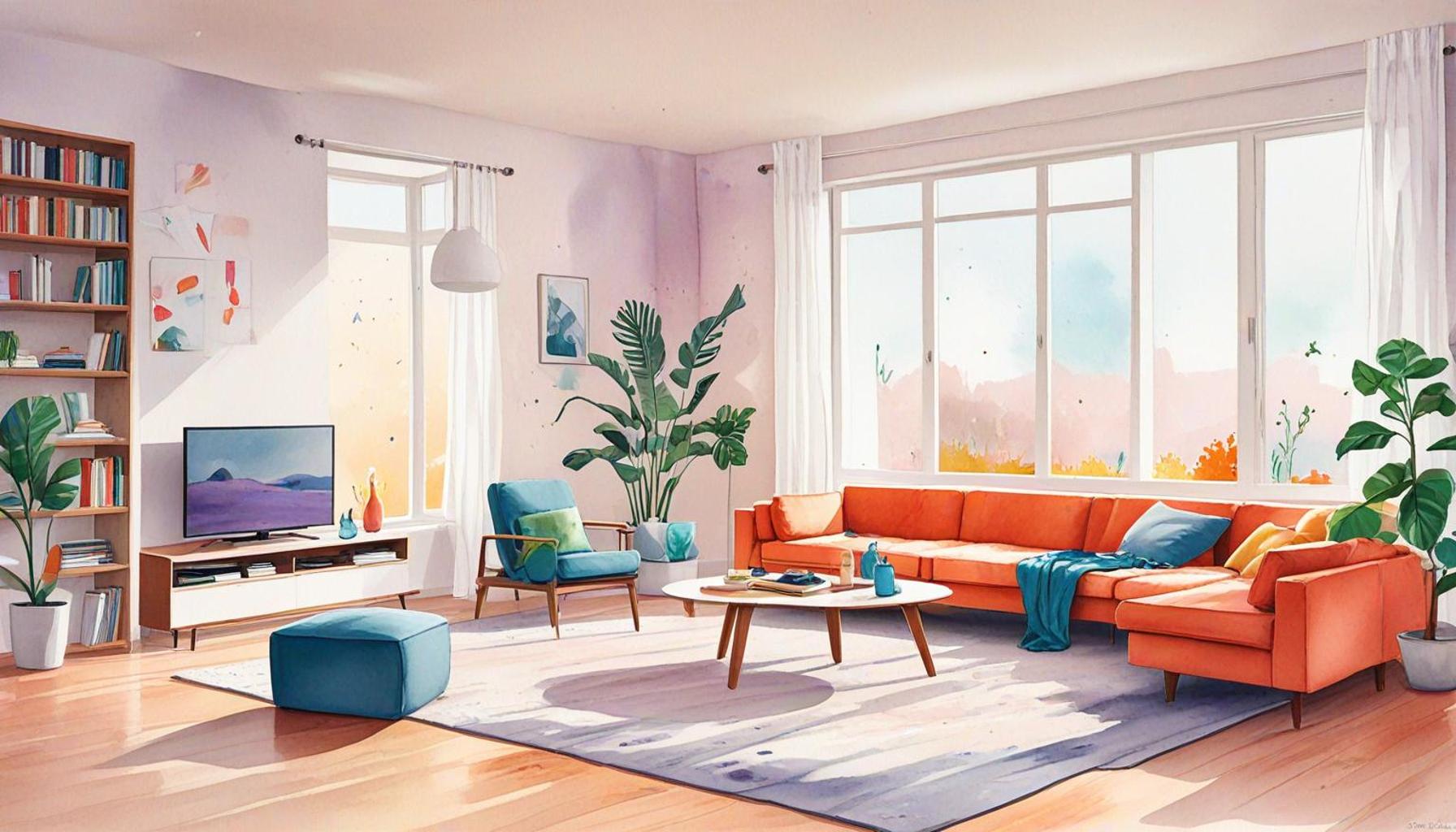Reinventing the Living Room: How Minimalism and Space Optimization Can Create Comfortable and Functional Environments

Embracing Minimalism for a Functional Living Room
As living spaces become increasingly confined, especially in urban areas of the United States, the allure of minimalism has become undeniable. This philosophy transcends mere decoration; it is a lifestyle choice that encourages individuals to prioritize what truly matters in their homes. By adopting a minimalist approach in the living room, homeowners can create not only a visually appealing space but also a more comfortable and functional environment.
At its core, minimalism emphasizes simplicity and functionality. When applied to home design, especially in commonly used areas like the living room, it involves:
- Decluttered spaces: Letting go of excess items opens up visual space and cultivates a sense of tranquility.
- Functional furniture: Choosing pieces that serve multiple purposes can maximize usability without compromising aesthetics.
- Thoughtful design choices: Every piece of furniture and decor should have a purpose, whether it’s to provide comfort, enhance aesthetics, or serve a practical function.
The journey toward space optimization is an exciting one. Homeowners should consider what they want their living spaces to achieve. For instance, the incorporation of multi-functional furnishings like a sofa bed allows a living room to morph into an inviting guest space. Nesting tables, which can be easily tucked away when not in use, illustrate how compact design can still offer versatility.
Moreover, the layout of the living room plays a crucial role in minimizing clutter and maximizing functionality. Strategic placement of furniture can enhance natural light flow and promote ease of movement. For example, arranging seating in a circular pattern encourages conversation while making the area feel more open. This optimizes the visual impact of the room, creating an inviting atmosphere that reflects a sense of harmony.
Incorporating personal elements—such as artwork, plants, or books—without overwhelming the minimalistic ethos is a delicate balancing act. Select pieces that resonate with you and add character to the space while ensuring they complement rather than clutter the overall aesthetic. This thoughtful integration of personal style allows for a home that feels lived-in and loved, rather than sterile.

Ultimately, transforming your living space through minimalism is about more than just decluttering; it’s an opportunity to enhance your quality of life. By embracing these principles, one can achieve a harmonious balance between style and practicality that truly elevates both the aesthetic and functionality of any living room.
DISCOVER MORE: Click here to unlock innovative storage solutions
Designing Smart with Space Optimization
Space optimization is at the heart of reinventing the living room, particularly in urban settings where square footage often comes at a premium. The application of minimalist principles can transform a cramped living space into an open, inviting environment that encourages relaxation and social interaction. Maximizing every inch of available space is essential, and this begins with understanding the layout and flow of the room.
To embark on an effective space optimization journey, homeowners should first assess their current living room configuration and identify opportunities for enhancement. Below are some key considerations that can lead to innovative and functional designs:
- Assessing Functionality: Begin by evaluating how you currently use your living room. Is it primarily for entertainment, relaxation, or as a home office? Understanding this will guide your choices in both layout and furniture selection.
- Utilizing Vertical Space: When floor space is limited, think vertically. Wall-mounted shelves and cabinets can store items without taking up valuable square footage. Additionally, vertical gardens or hanging planters can beautify the space without crowding it.
- Layered Lighting: Good lighting can make a small room feel larger. Consider implementing layered lighting strategies—overhead fixtures, table lamps, and floor lamps can work together to create depth and atmosphere while removing dark corners.
Furthermore, choosing the right furniture can significantly impact both aesthetics and functionality. Compact yet stylish pieces allow for a more free-flowing environment. For instance, opt for a slimline sectional sofa that provides seating without overwhelming the room. Coffee tables with hidden storage not only serve a practical purpose but also contribute to a more organized visual theme.
Seating can be another area to showcase space optimization. Instead of traditional bulky sofas, consider modular or two-piece sets that can be arranged depending on your needs or the occasion. This flexibility allows homeowners to entertain guests comfortably while maintaining a serene environment during quieter times.
In addition to furniture selection and layout, the strategy behind color schemes also plays a pivotal role in space perception. Light colors tend to reflect more light, making a room feel airy and open. Choosing a consistent palette can create a seamless flow from one area to another, enhancing the overall spacious feel.
As we dive deeper into the intricacies of minimalist living, it becomes evident that embracing these concepts not only addresses the practicalities of limited space but also aligns with a growing desire for mindful living. The journey to reinventing your living room through minimalism and space optimization fosters a home that is both beautiful and functional, ultimately enriching your daily life.
| Advantages | Details |
|---|---|
| Enhanced Comfort | A minimalist approach encourages decluttering, resulting in more open and inviting spaces that promote relaxation. |
| Improved Functionality | Utilizing multifunctional furniture, such as storage ottomans or extendable coffee tables, allows the living room to adapt to various needs and activities, optimizing the use of space. |
The philosophy behind minimalism emphasizes creating environments that foster tranquility and promote a sense of well-being. By embracing this approach, the living room becomes a sanctuary designed to reduce visual noise. As you incorporate space optimization strategies into your living room, consider how a well-organized space impacts not only physical comfort but also mental clarity.Select multi-purpose furnishings that serve a dual role while complementing the overall aesthetic. For instance, a sleek bookshelf can double as a room divider, allowing you to delineate spaces without sacrificing openness. When each piece of furniture is considered carefully, it supports the vision of a functional environment tailored to your lifestyle.Incorporating these methods invites further investigation into how the minimalist design can transform not only your living room but also your overall approach to home and space. Consider how these principles can lead to other inspiring designs that focus on simplicity and functionality.
DISCOVER MORE: Click here to learn about minimalism and productivity
Incorporating Multi-Functional Elements
Another cornerstone of reinventing the living room through minimalism is the incorporation of multi-functional elements. In today’s fast-paced world, homeowners seek versatility in their living spaces, particularly in rooms like the living room, where guests frequently gather. By choosing pieces that serve multiple purposes, homeowners can dramatically improve functionality without sacrificing aesthetics or comfort.
Consider furniture that serves dual roles. Sofa beds have come a long way from the uncomfortable options of yesteryears. Modern designs offer chic styles that seamlessly transition from day to night, providing a cozy place for guests to sleep without overtaking the room. Similarly, ottomans with storage capabilities can double as coffee tables, providing a place to rest drinks while hiding away blankets or books when not in use. These elements not only save space but also contribute to a cohesive and minimalist look.
Foldable and collapsible furniture also offers flexibility, allowing homeowners to adapt their space based on immediate needs. For instance, a drop-leaf dining table can expand for entertaining and then contract to allow more room for movement. This adaptability is vital in small living spaces, as it maximizes usability without unnecessary clutter.
The Power of Decluttering
Decluttering is an integral aspect of minimalism that ties directly to space optimization. The principle of “less is more” can be applied here, as a clean and organized environment enhances both visual appeal and functionality. To achieve this, homeowners should assess their belongings and consider what is essential. This process often begins with the 60/30/10 rule—keeping sixty percent of the room dedicated to main elements, thirty percent for secondary features, and ten percent for accents.
Engaging in periodic decluttering sessions can foster a sense of calm and clarity. Utilizing stylish storage solutions, such as decorative baskets or built-in cabinetry, allows homeowners to keep surfaces clear while maintaining easy access to necessary items. This approach not only enhances the room’s aesthetics but also makes daily life more manageable.
Art and Personal Touches
Minimalism doesn’t have to mean a sterile environment devoid of personality. Thoughtfully chosen artwork and decor can enrich a minimalist living room, providing character without overwhelming the senses. Large-scale artwork can serve as a focal point, drawing the eye and making a room feel more spacious. Black-and-white photography or abstract pieces often work well in minimalist settings due to their clean lines.
Furthermore, incorporating a few well-placed plants can introduce a natural element that livens up the space without significantly occupying room. Plants like snake plants or pothos are perfect choices; they’re stylish yet require minimal maintenance, aligning perfectly with a minimalist ethos.
Ultimately, reinventing the living room with these space optimization and minimalist approaches not only creates a visually appealing space but also cultivates an environment conducive to relaxation and connection. By embracing multi-functional furniture, engaging in consistent decluttering, and curating personal touches, homeowners can transform their living rooms into havens of comfort and efficiency, perfectly aligned with modern living practices.
DISCOVER MORE: Click here to learn about effective prioritization
Conclusion
In a world where space is often at a premium, reinventing the living room through minimalism and strategic space optimization emerges as a necessity rather than a trend. The essence of this transformation lies in creating environments that are not only aesthetically pleasing but also serve the practical needs of daily life. By incorporating multi-functional furniture, engaging in a thoughtful decluttering process, and adding personal touches through art and plants, homeowners can craft a living room that resonates with their lifestyle while maintaining a serene atmosphere.
As we embrace these minimalist principles, it becomes evident that less can indeed be more. The shift towards a simplified living space allows for greater flexibility, encouraging us to focus on what truly matters—connections with family and friends. Moreover, the adoption of sleek designs and intentional layouts can make even the smallest of spaces feel expansive and inviting. This approach not only enhances our living environments but also fosters a sense of calm amidst the chaos of modern life.
Ultimately, reinventing the living room is about more than decoration; it’s about creating a sanctuary that reflects individual values and relationships. With the right strategies, every homeowner can transform their living room into a functional and comfortable haven. The journey of minimalism and space optimization invites exploration, encouraging us to rethink and reimagine the heart of our homes, making room for joy, creativity, and connection in our everyday lives.
Related posts:
Digital Minimalism: The Art of Optimizing Your Virtual Workspace with Simple Tools
Zen Spaces: How Optimization and Minimalism Can Enhance Your Emotional Well-Being
Minimalism and Sustainability: Strategies for Space Optimization for an Ecological Lifestyle
Living Spaces: How Minimalism and Optimization Can Create Attractive Environments for Socialization
Creative Workspaces: How Minimalism Can Boost Productivity Through Optimization
Maximizing Small Spaces: Innovative Storage Solutions for Minimalist Living

Linda Carter is a writer and organization expert specializing in minimalism and personal organization. With extensive experience helping individuals create clutter-free, functional spaces and adopt mindful habits, Linda shares her knowledge on our platform. Her goal is to empower readers with practical advice and strategies to simplify their lives, stay organized, and achieve a sense of calm and balance in their daily routines.